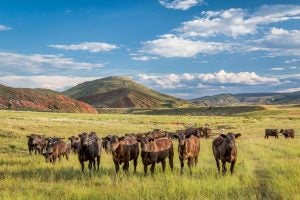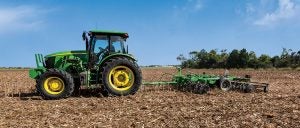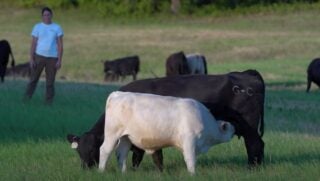Did you know that, in 2018, the U.S. Environmental Protection Agency reported that 28 percent and 27 percent of greenhouse gas emissions (GHG) came from the transportation and electricity sectors, respectively, and only 10 percent came from the entire agricultural industry?
As a beef advocate, I find myself sharing this message more and more on my platforms and having discussions with commenters and followers who want to know more about beef sustainability — which, by the way, is a sub-sector of agriculture contributing about 3 percent of GHG emissions.
If we zoom out to look at the entire agriculture industry, many of us recognize the efforts made by professionals even further to reduce emissions. Of course, it’s not perfect, but the ability of farmers and ranchers to sequester carbon and reduce the impact on the planet is something other industries can be inspired by, and something we are beginning to capitalize on. Our continuous search for new ways to create sustainability financially, and environmentally, means that it was only a matter of time before we got into carbon markets.
Wait. What are carbon markets?
According to SDG Finance, Carbon Markets “aim to reduce greenhouse gas (GHG, or “carbon”) emissions cost-effectively by setting limits on emissions and enabling the trading of emission units, which are instruments representing emission reductions. Trading enables entities that can reduce emissions at lower cost to be paid to do so by higher-cost emitters, thus lowering the economic cost of reducing emissions.”
What does this mean for the agricultural sector?
For decades now, sustainability has been a hot-button issue within the ag industry, and many in the industry have sought out ways to further incentivize reducing emissions. With carbon trading, this opens up a new revenue stream for farmers and ranchers who participate.

International governments have searched for ways to reduce climate change, enacting laws and regulations for companies to follow in order to offset carbon emissions. To comply with these laws, companies that emit large amounts of GHG, such as power plants, will pay other companies to reduce their carbon rather than change how they operate business. This works out relatively well for agricultural operations, though.
Because our industry can reduce our emissions at a lower cost than larger companies, and because we are already participating in those reductions, we have an ability to build what is called “carbon credits.”
According to Investopedia, carbon credits are “a permit that allows the company that holds it to emit a certain amount of carbon dioxide or other greenhouse gases. One credit permits the emission of a mass equal to one ton of carbon dioxide. The carbon credit is one half of a so-called ‘cap-and-trade’ program.”
Farmers and ranchers who sell these carbon credits to large companies, like power plants, can earn revenue in return. Simply for being more sustainable and adopting more efficient practices.
Ways that farmers and ranchers can reduce or offset their carbon footprint, according to Texas A&M Agrilife Extension, is by capturing or restoring emissions in the following ways:
“To reduce emissions, producers could:
- Decrease fertilization
- Alter manure management
- Reduce fuel consumption
- Change feeding practices
- Switch to alternative fuels, such as from coal to natural gas or bioenergy
- Produce biofuels feedstock
- Implement rotational grazing programs
Agriculturists can also capture and store emissions in a process called sequestration. One type of sequestration is biological sequestration, which uses the characteristics of plants to capture emissions. Agricultural forms of biological sequestration include:
- Changes in tillage practices
- Crop rotations
- Conversion of acreage to grasslands
- Afforestation, which is the planting of trees or seeds to change open land into forest or woodland, a practice that both reduces and sequesters emissions
Producers can look at the GHG and Carbon Sequestration Ranking Tool from USDA’s Natural Resources Conservation Service to find more information on the impact of different management practices.
However, it’s important to note that some of these production methods are costly and may not benefit ranchers and farmers in the long run.

What it all boils down to, according to Agrilife Extension, is knowing the answers to these following questions to determine if it is feasible for your operation:
- The origins of the carbon market
- Participants in that market
- Types of projects that agriculturists can undertake
- Status of the U.S. market
- Steps and requirements to participate in the carbon credits marketplace
- Potential cash flows for cropland and rangeland management offset projects
Of course, carbon markets are complex, and there are steps to follow in order to participate. To learn more about enrolling, and how to sell offsets, visit this Texas A&M Agrilife Extension article, which dives into further detail regarding the difference between Direct Contact and CCX, plus requirements to enroll.
As for the future of the carbon markets, well, the Biden administration is already on it. A piece published by Agri-Pulse Communications discusses that “a top adviser to Biden is proposing to create a carbon bank at USDA that would buy and sell carbon credits from farmers using a reverse action technique in which farmers bid the prices they want to be paid. The credits would then be sold to corporations such as energy companies that need to offset their greenhouse gas emissions.”
The article states that Food and Agriculture Climate Alliance, a new coalition — composed of groups such as the American Farm Bureau Federation, National Farmers Union, the National Council of Farmer Cooperatives, the Environmental Defense Fund, The Nature Conservancy, The Food Industry Association, National Alliance of Forest Owners, and the National Association of State Departments of Agriculture — is on board with this carbon bank.
The Agri-Pulse article also lists many other programs that are in the works or already in existence:
- “The Ecosystem Services Market Consortium, whose founders include food and agribusiness companies such as General Mills, McDonald’s and Cargill, is already paying a few farmers in preliminary transactions and intends to open a broad-based private carbon market in 2022, paying farmers for a full menu of emission reducing practices.
- “Indigo Ag, a high-tech farmer services firm, invited growers in mid-2019 to make 10-year commitments to sequester soil carbon at $15 per verified ton. American farmers have contracted 7.5 million cropland acres to apply climate-saving practices for 10 years and have already implemented practice changes on over 1 million acres.
- A year ago, the Seattle-based Nori Carbon Removal Marketplace appeared, offering individuals and businesses the choice to go online and use their credit cards to pay farmers for storing soil carbon. On the farmers’ side of the bargain, Nori invites farmers to use a computer app, COMET-Planner, to estimate of how much soil carbon they can sequester, pay an expert to verify, and then sell it via Nori.
- Bayer is getting in on the act with a new Carbon Initiative that aimed to enroll 1,200 farmers in the United States and Brazil during the current marketing year. Bayer will pay farmers for the value of “carbon removal” practices. In Brazil, a government-run agricultural research agency will be enlisted to develop sampling tools to measure the practices’ impact. Bayer thinks the program may help meet the goals of the European Green Deal, the European Union’s plan to cut Europe’s greenhouse gas emissions and address other environmental challenges. By the end of the enrollment period in October, farmers had enrolled over 200,000 corn and soybean acres.
- There are regional efforts, too. The Florida Climate Smart Agriculture group is partnering with the University of Florida Institute of Food and Agricultural Sciences to develop the framework of payments for ecosystem services along with a tool to measure the services provided.
- California, which is the nation’s pioneer in using carbon markets to try to reduce emissions, created a cap and trade system that requires power plants, refiners, manufacturers and other polluters to reduce their carbon emissions or buy permits. Revenue from the permits has helped fund the widespread installation of dairy digesters, equipment on dairy farms that captures the methane gas emitted by manure to generate power.”
While carbon markets may not be for everyone, it shows how willing and able our industry is to reduce carbon emissions and be a positive impact on the environment. Time will tell whether this trendy market creates enough incentive, and is sustainable itself, for farmers and ranchers to participate in.
Markie Hageman lives in California and is an agribusiness graduate from Fort Hays State University. She is the Communications Coordinator for California Rangeland Trust and is an avid agriculture advocate. Her AGDAILY articles can be found here.



